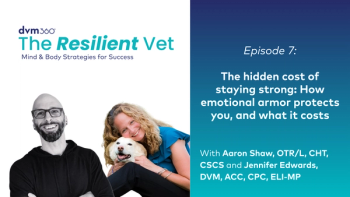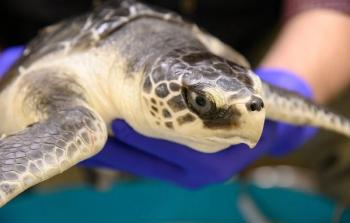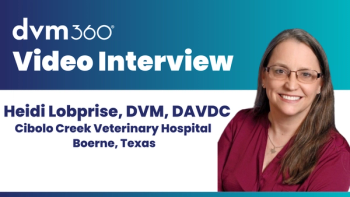Ihrke presented a list of 5 management goals for dogs with OA:
- Intervene early.
- Improve quality of life.
- Reduce pain.
- Decrease flare-ups.
- Increase daily activity.
These goals are best accomplished, she said, using a multimodal and comprehensive approach.
Medical management
One of the starting points of treatment is nonsteroidal anti-inflammatory drugs. Adjunctive therapies such as amantadine, amitriptyline, or gabapentin (or combinations thereof) may also be used. Disease-modifying agents such as polysulfated glycosaminoglycans may also be beneficial and are commonly used. Omega-3 fatty acid supplements, chondroprotective supplements, and diets rich in eicosapentaenoic acid are also beneficial.
Weight optimization
Ihrke sais this term is often better received by owners than “weight loss” or “diet,” and can have a great impact. Weight loss of 6.10% has been associated with a subjective decrease in lameness, and improvement on kinetic gait analysis can be seen with a weight loss of 8.85%.5 As such, her goal for patients is a standard 10% reduction in body weight, as weight optimization alone may help reduce clinical signs of OA.
Rehabilitation
Rehabilitation is part of the multimodal approach, but in itself is also multimodal. Environmental modifications to improve traction in the home (eg, carpet, yoga mats, booties) is 1 component. There are also many therapeutic aids, in addition to manual therapy. Thermotherapy employs a combination of cold packs (to reduce acute-phase inflammation) on affected joints, with hot packs (to increase blood flow, improve connective tissue extensibility, and promote muscle relaxation) on soft tissues in the surrounding regions. Other therapies include transcutaneous electrical nerve stimulation, which provides pain relief and can be used at home; photobiomodulation (therapeutic laser); hydrotherapy, which can reduce the load on hip joints by 60% when water is at hip level; therapeutic ultrasound; pulsed electromagnetic field therapy; and extracorporeal shockwave therapy. All of these modalities are used to reduce pain and inflammation or improve muscle relaxation and mobility. As such, some may be targeted to the affected joint and others on the adjacent muscle groups.
Manual therapy remains the most essential aspect of rehabilitation. “Above all other rehabilitation tools, manual therapy is always a component—and the cornerstone—of the treatment protocol,” Ihrke said. Manual therapy includes releasing trigger points, improving joint range of motion, and decreasing pain through massage.
The second most important aspect of the rehabilitation protocol is a therapeutic exercise program. “Fitness in dogs is not achieved via self-directed activities,” Ihrke said. “Walking around the yard is not the same as an intentional plan to target a specific group of muscles or a specific movement.”
Much like rehabilitation aids can be used to improve a patient’s pain control or function, intraarticular injections (eg, hyaluronic acid or corticosteroids) may do the same. These are administered on a case-by-case basis and are always prescribed alongside a corresponding rehabilitation plan. Further, intra-articular injections of platelet-rich plasma or stem cells may have a role in the future, particularly in early OA.
Setting SMART goals
All of these aspects of evaluation and treatment circle back to setting goals for the patient. The goals set by a clinician must take into account the goals of the owner and the role of the patient (whether it is a pet, working dog, or performance dog). If the owner’s goals are unrealistic, have a discussion to reach a reasonable consensus. Ihrke advised setting SMART goals with clients: specific, measurable, attainable, relevant, and time-based. An example of a SMART goal is to improve weight-bearing of the right pelvic limb by 15% (relevant, measurable, and specific) in 4 weeks (time-based and attainable).”
Summary
Ihrke’s comprehensive patient evaluation plan includes signalment, a thorough patient history, gait evaluation, physical examination, and diagnostic testing. A multimodal treatment protocol, including medications, weight optimization, supplements, and rehabilitation, is best implemented in the earliest stages of joint progression when possible. In this way, we can provide the most benefit to dogs suffering from OA that need our help to maintain a favorable quality of life.
Rebecca A. Packer, DVM, MS, DACVIM (Neurology/Neurosurgery), is an associate professor at Colorado State University College of Veterinary Medicine and Biomedical Sciences in Fort Collins. She is active in clinical and didactic training of veterinary students and residents and has developed a comparative neuro-oncology research program at Colorado State University.
References
1.Johnston SA. Osteoarthritis. Joint anatomy, physiology, and pathobiology. Vet Clin North Am Small Anim Pract. 1997;27(4):699-723. doi:10.1016/s0195-5616(97)50076-3
2. Fox SM. Multimodal Management of Canine Osteoarthritis. CRC Press; 2017.
3.Introducing a logical, comprehensive staging tool for canine osteoarthritis. American Animal Hospital Association. November 1, 2019. Accessed October 14, 2020.https://www.aaha.org/publications/newstat/articles/2019-11/introducing-a-logical-comprehensive-staging-tool-for-canine-osteoarthritis/
4. Roe SC. Diagnosis and conservative management of joint disease. Paper presented at: 32nd Congress of the World Small Animal Veterinary Association Proceedings; August 19-23, 2007; Sydney, Australia. Accessed October 14, 2020. https://www.vin.com/apputil/content/defaultadv1.aspx?meta=Generic&pId=11242&id=3860763
5.Marshall WG, Hazewinkel HA, Mullen D, De Meyer G, Baert K, Carmichael S. The effect of weight loss on lameness in obese dogs with osteoarthritis. Vet Res Commun. 2010;34(3):241-253. doi:10.1007/s11259-010-9348-7





